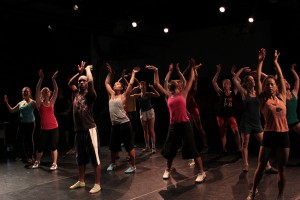Hello folks,
This past summer, journalist Bruce Walsh wrote a short series of articles centered around our work this summer on Private Places, then called The Flight Attendants Project. Below is the first article from Bruce, in which he encounters Jumatatu Poe (the project’s director) and Caleb Levengood (scenic designer) working on the project.
*also, check out our One-Year Vlog Project
_________________________________________________
Modern Dance for Beginners
Jumatatu Poe traverses the barrier between audience and dance
On a blustery January night, an invited audience packs themselves neatly into the Performance Garage for an in-progress performance of Jumatatu Poe’s FLATLAND 2010.
Twenty minutes into the show eleven dancers come bounding off the stage, darting up the aisles and tiptoeing lengthwise between the rows. Each dancer chooses someone to confront and what follows is indeed confrontational: while forcing eye contact, the dancer trembles with a growing fury, eventually releasing guttural, hiccupping bits of jumbled verbiage at their patron of choice.
When mulled over after the showing, the tactic makes perfect sense. FLATLAND is an exploration of the loss of intimacy in a culture dominated by two-dimensional social media. The moment forces audiences and dancers to confront the visceral, needy, uncomfortable aspects of an individual—the parts of a person we typically keep at arm’s length, a distance made all too easy by digital communication.
But in the moment—with dancers convulsing in their laps—the audience vacillates somewhere between awkward self-consciousness and downright freaked-outedness. “Please don’t choose me,” a woman murmurs to no one in particular, and stares at her shoes.
It’s a problem Poe is acutely aware of, but he’s not willing to dismiss the experiment. Despite these difficulties, audience interaction illuminates the basic question he poses in nearly all of his work: In what ways does this society obscure the human heart?
“It’s just something I’m really interested in about contemporary communication. What does it mean to shift our psychology as performers?” says Poe, sitting onstage at the Live Arts Brewery, where he is currently developing a new work, The Flight Attendants Project. “What does it mean to communicate with an audience member as they’re performing the role of the audience at that time? I want to see those two psychologies—performer and audience—intersect.”
Attendants was inspired by the book The Managed Heart: Commercialization of Human Feeling (University of California Press, 1985) by Arlie Hochschild, a Berkley sociologist. In it, Hochschild argues that the service industry has co-opted the psychological process we naturally use to manage our emotions: waiters, baristas, tour guides, bartenders and—you guessed it—flight attendants, must compartmentalize their feelings and perform with a smile.
Earlier this year, a duet version of Attendants was presented in Seattle and Minneapolis as part of the SCUBA National Touring Network for Dance. Poe received a $50,000 grant from PEW/Dance Advance to further develop the piece with his company, idiosynCrazy productions. (This article is part of the journalistic component of the Dance Advance grant.)
“I was a little worried at first. Audience interaction is a tricky business,” says Caleb Levengood, a New York set designer who has been hired by Poe to collaborate on Attendants. “The danger is that you push the audience to the point where all they’re concerned about is how they look to other people. But when I saw the video of the [original duet] performance, I saw something really fascinating. People were sitting onstage, but they were given a well-defined role, and that allowed them to be comfortable. I suddenly realized, ‘Oh, they’re passengers on the plane. They’re scenery! I can work with that.’”
* * *
“Now I’m getting a little obsessed with this,” says Poe, as he carries chairs two-by-two onto the stage at the Live Arts Brewery performance space. I’ve asked him to give me a broad sense of where the audience will sit—at least for the initial in-progress version on July 31. But now he can’t stop adjusting the chairs. Precise placement is important, however, since the choreography will be based on visual cues from the audience: i.e., a patron crosses her legs, triggering a specific movement phrase from the dancers.
Three long pillars of seats shoot out from center stage like spokes on a wheel. The seats are arranged in pairs, an arrangement akin to a cramped midsize commercial flight.
Three of Levengood’s set pieces sit center stage: a serving cart and a pair of human-wingspan-length muslin rectangles that suggest a fuselage. “I’ve come to realize that this show is not about designing a set for a play,” says Levengood, sitting in one the simulated passenger aisles. “It’s about giving the performers added possibilities . . .”
Before he can finish, Poe has placed himself inside the serving cart and is crawling up the aisle propelled by his hands and arms while his lower body is concealed within the cart. It’s a nightmarish, crablike effect.
“I never thought you’d do that with it!” says Levengood, with a hooting laugh.
I invite Poe to sit with us for the interview. He gracefully dislodges himself from the cart and intentionally cuts across the aisle I’m sitting in on his way to the adjacent seat.
“See how you’re dancing already?” he says. And I’m suddenly conscious of the way my legs instinctively shift when someone passes me in an aisle of seats.
I’ve never been called a dancer before but in this fleeting moment, perhaps I am.
– Bruce Walsh
 of the source inspirations for Private Places: flight attendants and J-Sette performance. We are looking for small groups* (of two or three people each) to submit videos of their hottest “Stewardess Buck” sequences. In a “Stewardess Buck,” we are looking for routines that are dynamic in the following ways:
of the source inspirations for Private Places: flight attendants and J-Sette performance. We are looking for small groups* (of two or three people each) to submit videos of their hottest “Stewardess Buck” sequences. In a “Stewardess Buck,” we are looking for routines that are dynamic in the following ways:
